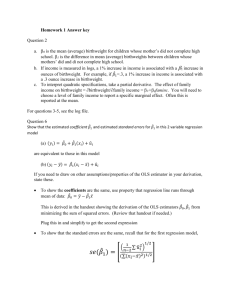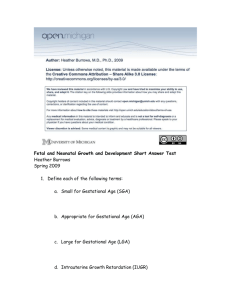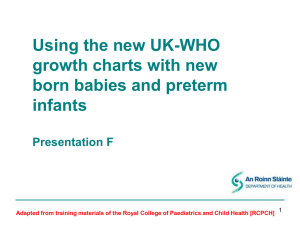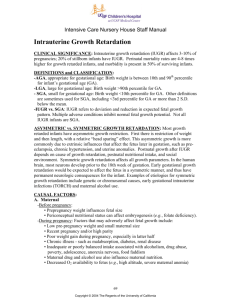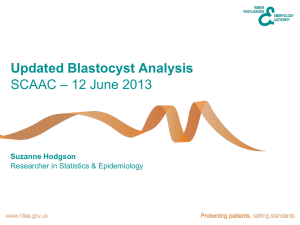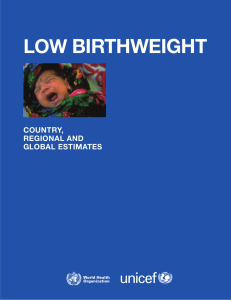INTRAUTERINE GROWTH RETARDATION IN NEWBORN CHILDREN
advertisement
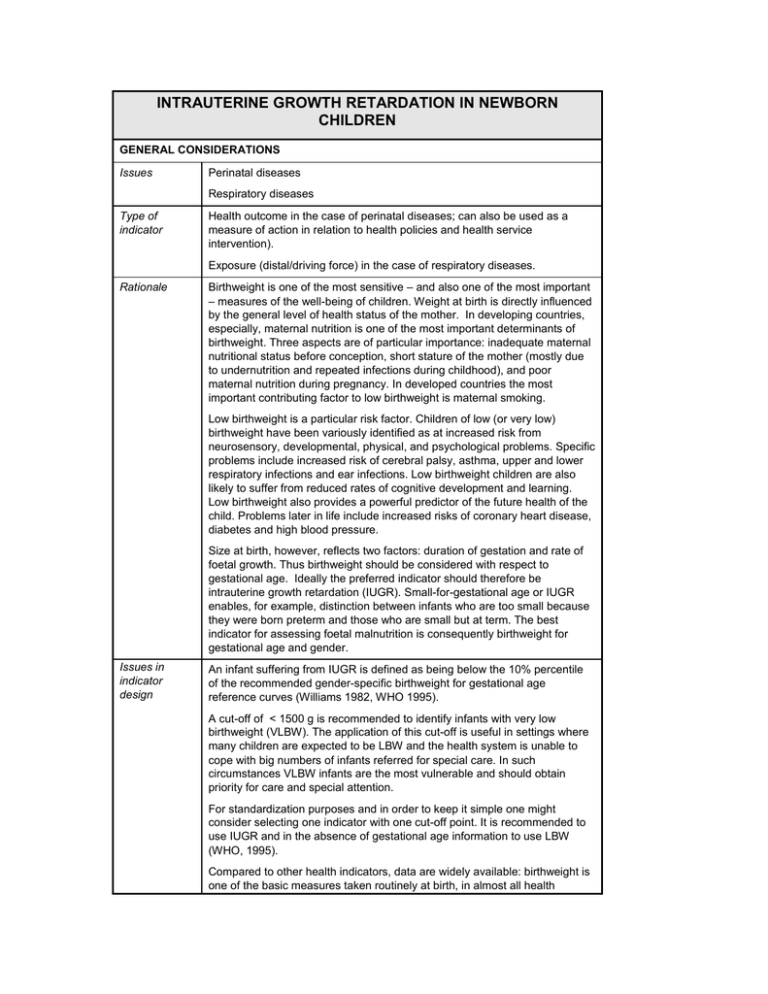
INTRAUTERINE GROWTH RETARDATION IN NEWBORN CHILDREN GENERAL CONSIDERATIONS Issues Perinatal diseases Respiratory diseases Type of indicator Health outcome in the case of perinatal diseases; can also be used as a measure of action in relation to health policies and health service intervention). Exposure (distal/driving force) in the case of respiratory diseases. Rationale Birthweight is one of the most sensitive – and also one of the most important – measures of the well-being of children. Weight at birth is directly influenced by the general level of health status of the mother. In developing countries, especially, maternal nutrition is one of the most important determinants of birthweight. Three aspects are of particular importance: inadequate maternal nutritional status before conception, short stature of the mother (mostly due to undernutrition and repeated infections during childhood), and poor maternal nutrition during pregnancy. In developed countries the most important contributing factor to low birthweight is maternal smoking. Low birthweight is a particular risk factor. Children of low (or very low) birthweight have been variously identified as at increased risk from neurosensory, developmental, physical, and psychological problems. Specific problems include increased risk of cerebral palsy, asthma, upper and lower respiratory infections and ear infections. Low birthweight children are also likely to suffer from reduced rates of cognitive development and learning. Low birthweight also provides a powerful predictor of the future health of the child. Problems later in life include increased risks of coronary heart disease, diabetes and high blood pressure. Size at birth, however, reflects two factors: duration of gestation and rate of foetal growth. Thus birthweight should be considered with respect to gestational age. Ideally the preferred indicator should therefore be intrauterine growth retardation (IUGR). Small-for-gestational age or IUGR enables, for example, distinction between infants who are too small because they were born preterm and those who are small but at term. The best indicator for assessing foetal malnutrition is consequently birthweight for gestational age and gender. Issues in indicator design An infant suffering from IUGR is defined as being below the 10% percentile of the recommended gender-specific birthweight for gestational age reference curves (Williams 1982, WHO 1995). A cut-off of < 1500 g is recommended to identify infants with very low birthweight (VLBW). The application of this cut-off is useful in settings where many children are expected to be LBW and the health system is unable to cope with big numbers of infants referred for special care. In such circumstances VLBW infants are the most vulnerable and should obtain priority for care and special attention. For standardization purposes and in order to keep it simple one might consider selecting one indicator with one cut-off point. It is recommended to use IUGR and in the absence of gestational age information to use LBW (WHO, 1995). Compared to other health indicators, data are widely available: birthweight is one of the basic measures taken routinely at birth, in almost all health services. Data are less likely to be available, however, in more remote areas, where births are unsupervised. Thus, data may tend to be lacking or incomplete in the areas most affected by severe malnutrition. SPECIFICATION Definition Incidence of low or very low birthweight Terms and concepts Intrauterine growth retardation: birthweight below the 10 percentile of the recommended gender-specific birthweight for gestational age reference curves (Williams1982, WHO 1995). th Number of live births: number of live births in the survey period Data needs Number of births by birthweight, gestational age and gender Total number of live births Data sources, availability and quality Birthweight is routinely collected only in developed countries where the great majority of births take place in health facility settings. According to statistics presented by UNICEF, two-thirds of all births world-wide are not weighed (UNICEF, 2001). Databases maintained by UNICEF and WHO rely primarily on facility-based and other routine reporting systems which are known to be biased when applied for national reporting purposes, particularly in developing countries. UNICEF has recently incorporated into their database household survey data (Demographic and Health Surveys and Multiple Indicator Cluster Surveys) using a subjective assessment by the mothers, qualifying their infants' size at birth as very large, larger than average, average, smaller than average, or very small. These estimates are of limited quality given that they are highly aggregated and the mother’s subjective assessment of size tends to be biased towards the larger end of the scale (Blanc and Wardlow, 2002). Routine data on the number of live births are available from a number of sources, including vital registrations, sample registration systems, surveillance systems and censuses and demographic surveys (such as the demographic and health surveys of world fertility surveys). Information is also collated by the UN on a regular basis. Vital registration is incomplete in many parts of the world, however, and survey data are of varied quality, especially in remote rural areas. For this reason, rates based on civil registrations or hospital data may be biased towards the more affluent, urban sectors of the population. Level of spatial aggregation Administrative district Averaging period Annual Computation The indicator can be computed as: 100 * Biugr / Blive where: Biugr is the number of babies classified as affected by intrauterine growth retardation (i.e. below the 10 percentile of the recommended gender specific birthweight for gestational age reference curves (Williams,1982; WHO, 1995) during the survey period; Blive is the total number of live births during the survey period. Units of measurement Percentage Worked example Assume that there are 1 553 cases of IUGR in an area, from a total of 11 400 live births. In this case, the value of the indicator will be: 100 * (1 553 / 11 400) = 13.6% Interpretation Impairments in foetal growth - as assessed by IUGR - can have adverse consequences in infancy and childhood in terms of mortality, morbidity, growth and performance (WHO, 1995). IUGR classification of a newborn has implications for diagnosis, prognosis, surveillance, and treatment. IUGR infants are more likely to have congenital anomalies, and surveillance of IUGR infants should include monitoring for oxygenation and respiratory status, neonatal sepsis, and neurological complications (WHO, 1995). Some care is needed in making comparisons between different countries, or over long time periods, however, because of changes in reporting mechanisms and efficiency. Differences may also exist in the definition of live births, while variations in the level of health service provision may affect survival of IUGR babies. Interpretation of trends or patterns in IUGR in relation to malnutrition also needs some degree of caution, since nutritional levels are not the only determinant of intrauterine growth. Other factors, such as smoking behaviour and exposure to air pollution may also be important. Variations and alternatives Following the recommendations made by the WHO Expert Committee (WHO, 1995), where gestational age is not available, birthweight < 2500 g (LBW) can be used as a proxy. It should be born in mind, however, that using LBW, considerably underestimates the magnitude of IUGR (de Onis et al, 1998). In more extreme situations, where many children are expected to have LBW and the health system is unable to cope with the large numbers of infants referred for special care, it may be more appropriate to use very low birthweight (VLBW) as a proxy. This is defined as children with a birthweight < 1500 g. VLBW infants are the most vulnerable and should obtain priority for care and special attention. Examples UNICEF The state of the world's children · Percentage infants with low birthweight Useful references ACC/SCN 2000 The fourth report on the world nutrition situation: nutrition throughout the life cycle. Geneva: Administrative Committee on Coordination, Subcommittee on Nutrition. Blanc, A.K. and Wardlaw, T. 2002 Survey data on low birthweight: an evaluation of recent international estimates and estimation procedures. Annual Meeting of the Population Association of America, Atlanta, May 9-11, 2002. de Onis, M., Frongillo, E.A. Jr. and Blössner, M. 2000 Is malnutrition declining? An analysis of changes in levels of child malnutrition since 1980. Bulletin of the World Health Organization 78, 1222-33. Mosley, W.H. and Gray, R. 1993 Childhood precursors of adult mortality in developing countries: implications for health programs. In: Gribble, J. and Preston, S.H. The Epidemiological Transition: Policy and Planning Implications for developing countries. Washington: National Academy Press, Pp. 69-100. UNICEF 2000 The state of the world's children, 2000. Progress since the World Summit for Children: A statistical review. New York: United Nations Children’s Fund, 2001. (Available at http://www.unicef.org/sowc00/ ) UNICEF website: www.childinfo.org/eddb/lbw/index.htm WHO 1995 Expert Committee Report: Physical status: the use and interpretation of anthropometry. Technical Report Series 854. Geneva: World Health Organization. WHO 1996 Catalogue of Health Indicators: A selection of important health indicators recommended by WHO Programmes. WHO/HST/SCI/96.8. Geneva: World Health Organization. WHO 1997 The WHO Global Database on Child Growth and Malnutrition. WHO/NUT/97.4. Geneva: World Health Organization. Williams, R.L., Creasy, R.K., Cunningham, G.C., Hawes, W.E., Norris, F.D. and Tashiro, M. 1982 Fetal growth and perinatal viability in California. Obstetrics and Gynecology 59, 624-32.
